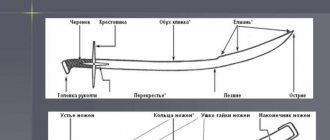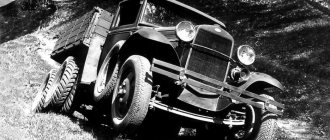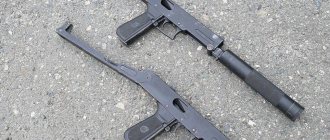Collapsible roof on GAZ-69
When I had a GAZ-69, I made it a metal roof.
But the TU set itself the following: 1 - if it is removed from the car, the roof should not take up much space in the garage. 2 - dismantling and installation of the roof could be done without assistants. In the end, this is what happened (the process of dismantling the roof): The roof is assembled
First, the door extensions and the rear clapper are removed.
Then the sides of the roof are unscrewed. Since everything is done alone, instead of temporarily supporting the roof boat, I used a shovel)))
Well, the boat itself is actually removed.
Well, that's it.
The roof consists of three parts - a top boat and two sides. It is welded from a 20x20x1 profile, the outside is covered with galvanized steel 0.4 mm thick, the inside is lined with 2.5 mm hardboard, which in turn is covered with carpet. PPE-10 (polyethylene foam 10 mm, commonly foam) is glued between the galvanization and hardboard.
I fastened the door extensions like this: I drilled a hole with a diameter of 18 mm in the door, welded an M8 nut onto a 3 mm plate, then turned the plate over with the nut down, placed it on the door, placing the nut in the hole, and welded the plate onto the door.
Source
Roof of GAZ-69. Part... the next one, very similar to the previous one, but with a description.
At the request of comrade pilotriver, in the previous part I will try to describe the manufacture of my hard roof on a GAZ-69 without photos. Unfortunately, the disk with the photos died and only crumbs remained.
I will quote the questions asked so that the ignorant can understand:
Is it possible to go into more detail: 1) how the roof fits into the windshield frame 2) how the sides of the roof are attached to the sides of the body 3) how the issue of water leakage at the joints is resolved 4) it’s clear with the sidewalls, but how to install and remove the boat yourself, like, how much does it weigh?
Looking ahead, I’ll say right away that from personal experience I recommend starting the manufacture of the roof “from below”! That is, first make the fastening of the sidewalls to the body, then the sidewalls themselves. The fact is that Gazik’s body is not symmetrical. and therefore almost everything must be done at the location of a specific machine. Of course, it will be possible to move the roof from one car to another, but it will require straightening either the roof or the sides of the car))) Next, you should start the boat from the part adjacent to the windshield frame. But these are recommendations, not instructions for action.
And so on the points of the questions asked (and not in the order of production):
1 — the roof is not attached to the windshield frame at all))). She just lies there. But in order for it not to leak, here we had to tinker. It wasn’t that it was labor-intensive, it was just a very carefully adjusted roof part, which is why it took a lot of time. I did it simply: I took a thin-walled pipe (1 mm wall), which in diameter is close to the diameter of the glass frame pipe (let's call it a blank). I bent it to the shape of the frame, then cut it lengthwise from the bottom and straightened the edges so that it looked like the letter “U”, only upside down. I hope it's clear. Next, I adjusted the “blank” so that it fits tightly onto the glass frame. I cut the front (according to the movement of the car, the outer) shelf of the workpiece so that it was closer to the glass. The back side of the workpiece, which faces the salon, was trimmed at the end, when the frame of the boat was almost ready. At the end of making the roof, I glued a thin “E”-shaped glass seal inside the “blank”.
This was enough to stop the roof from leaking. That is, it turned out that the roof seemed to snap onto the windshield frame. The only thing I had to do was cut off the glass lifting hinges. And yes - the frame from the A-shki will not fit due to the influx under the awning, you need one from the 8-seater.
2 - The roof begins with the manufacture of the lower part of the sidewalls. I took a 35x35 steel construction angle and cut one shelf lengthwise to 15 mm. The result was a corner 35x15. You don’t have to do this, I just really wanted to remove at least an extra 400-500 grams from the roof. 5 grams here, 10 grams there, in the end an extra kilogram, it just rhymes))) This corner, bent from the rear to the shape of the side of the body, will be the base of the side of the roof. It is a corner, not a profile, because... it will be screwed to the side. If you make it from a profile, you will have to weld in embedded tubes so that when bolted, the profile does not flatten.
Then I reinforced the inner plane of the side (since the side is only 1.2 mm thick), on which the side of the roof fits, with strips of 2 mm pieces of iron with nuts welded to them. The fastening bolts of the roof sides were screwed into these nuts. The embedded strips themselves were welded to the side using electric rivets.
3 - Water leakage at the joints is also solved using an “E”-shaped seal.
4 - I don’t remember exactly, but the boat turned out to be somewhere around 40 kilograms. Basically, when my garage was busy, I managed it alone. It's inconvenient, of course, but it's possible. And in the garage there are no problems at all - I tied the roof to the floor logs, unscrewed everything, lifted the roof and drove out from under it)))
PS: And for those who will repeat the design, pay attention to the rear vertical corners of the sidewalls and roof boats.
On the sidewalls the corner is round (oh, this Russian language)))) with a much smaller radius than the corner of the body. And the angle of the boat is just that: an angle. This technical solution made it possible to make the transition from the rounded corner of the body side to the rectangular corner of the roof unnoticeable, and not to be distorted by making a radius bend on the roof.
Source
Technical tuning of a Soviet rarity - replacing the engine and gearbox
The first element that needs to be changed in a car is the engine. Most power units supplied with the latest UAZ and GAZ models are suitable for this. When choosing a motor, you should pay attention to power and torque. It is best if you manage to find an “engine” with a capacity of at least 110 hp. With. and a torque of more than 180 Nm. You can install the new power unit yourself. To do this you will need:
- lift;
- set of wrenches;
- screwdriver set;
- bolts for mounting a new motor;
- welding machine;
- drill;
- aluminum angle for mounting the engine.
Replacing the engine of a GAZ 69 car
Similar articles
Tuning GAZ 2410 – a bright classic
Gas 31105 - how to upgrade a factory-tuned car
Kenguryatnik on Gazelle - expanding the capabilities of the domestic minibus
Volga tuning - methods for reviving a legendary car
First you need to place the car on a flat surface. After this, open the hood and hook the standard GAZ 69 engine with the lift hook. Slowly lift the engine, then disconnect the fuel supply hoses and the clutch channel. We completely remove the SUV’s engine and begin cleaning the free space. You need to be extremely careful so that the detergent does not get inside the clutch channel.
After cleaning, you need to weld the corner. To do this, measure the length and width of the seat and cut out a suitable aluminum part. We weld a corner in the lower part of the body, and then drill holes in it for the bolts. We hook up the new engine and carefully install it under the GAZ hood. Without lowering the engine all the way, connect the free hoses. We put the power unit in place and secure it with bolts. Next, we move on to the second stage of tuning - replacing the gearbox with your own hands.
This is interesting: Nissan NV200 - characteristics and design
Foreign roots, pre-heater and hard top: myths and facts about the GAZ-69
This car is well known, remembered and even nostalgically loved by older generation drivers, many of whom no longer drive today. But younger motorists had virtually no experience with the GAZ-69, which was the reason for the emergence of funny myths related to the development history and design features of the legendary “goat.” Today we will try to understand the most interesting, but not indisputable statements about the GAZ-69.
There is an opinion that Soviet SUVs were created not just with an eye on foreign prototypes - the engineers of our factories almost made prototypes on someone else’s frame. American jeeps of those years (Willys MB), as well as Land Rover, invariably appear in conversations.
| It is appropriate to compare the legendary Willys with the GAZ-67, but not with the “sixty-ninth”, since the “goat” is larger, more spacious and more comfortable |
| The British SUV appeared almost at the same time as the Gazik. These cars were related more by concept than by design or technology. |
The fallacy of this opinion is shattered by the document from which GAZ began taking the new model seriously. After all, Decree of the Council of Ministers of the USSR No. 1118-325 and the subsequent order of the Ministry of Automobile and Tractor Industry No. 34 ordered Gorky engineers to create a new car with significant unification with the GAZ-20 Pobeda, including the engine and many transmission and chassis components. In fact, the frame SUV was supposed to be built on the components of a passenger car - of course, with the exception of all-wheel drive units.
Therefore, not only the engine with the gearbox, but also the steering mechanism, shock absorbers, brakes, optics and battery for this car were taken from serial Soviet cars and trucks.
Moreover, it was not our GAZ car that had a foreign prototype, but on the contrary - a foreign-made car was created on the basis of the GAZ-69! Indeed, in 1957, technical documentation for the GAZ-69 was transferred to Romania to the IMM plant without purchasing a license, and in 1962 - to North Korea. True, Romanian SUVs had a “foreign heart” - a 50-horsepower MAS gasoline engine.
Having produced only 2,000 copies in just over two years, the Romanians in 1959 created a modernized car with the M59 index, which differed from the “goat” in a four-speed gearbox and other axles. Five years later, in 1964, the car received a more powerful overhead valve engine. Interestingly, Romanian unlicensed copies even competed with the Soviet source in some foreign markets, because the GAZ-69 was exported to more than 50 countries around the world! The ARO-M461 was produced until 1975, outliving its original from the USSR by a couple of years.
The GAZ-69 was conceived both as a light transport for military personnel and for agricultural workers, geologists and government employees working in rural areas. It is no coincidence that the prototypes bore the name “Truzhenik”, which for some reason did not catch on on production cars. Soon after production began in 1953, the “target audience” was able to appreciate the off-road potential, which commanded the respect of everyone who tested the small car in action.
Despite the passenger power unit, the “goat” could actually overcome a ford up to 0.7 m deep, and also confidently stormed thirty-degree climbs and slopes. The recipe, as in the case of the GAZ-67, turned out to be simple to the point of genius - high ground clearance (210 mm), short wheelbase, all-wheel drive and virtually no overhangs.
But it worked so well only in combination with good weight distribution and well-chosen transmission numbers with a two-speed transfer case, which allowed the not-so-powerful car to literally work wonders off-road.
Moreover, the “sixty-ninth” could drive on dirt roads and rough terrain even a little faster than its predecessor, and the level of comfort (if this word is applicable here) was higher than in the GAZ-67.
The GAZ-69 was originally designed with a two-door, eight-seater body, in which the driver and passenger sat in the front, and the other six passengers sat on longitudinal benches in the rear. In the cargo version (with folded benches), the vehicle could carry up to 500 kg of cargo.
However, a prototype of a more comfortable four-door, five-seater version of the GAZ-69A (body 77) appeared even before the state tests of the GAZIK, which took place from September to June 1951.
The cars differed not only in the number of doors and seats, but also in the location of the spare wheel. On the cargo-passenger version, the spare tire was mounted outside on the left side behind the driver's door, and on the five-door version it was located in the trunk. Also on the GAZ-69A there was one 60-liter tank, and on the two-door version there were two tanks (47 l and 28 l), with an additional tank of smaller capacity located under the front passenger seat, and to refuel you had to open the right door.
| The low-valve engine from Pobeda, thanks to a two-stage transfer case, turned out to be a suitable unit for an SUV | |
| The first prototypes of the new machine called “Truzhenik” were ready by the end of 1947 | |
| "Gazik" could be found in various corners of the globe | |
| The layout of the GAZ-69 was extremely utilitarian | |
| Know ours: in 1972, the Italian Luigi Martorelli, driving a GAZ-69, took first place in the rally for all-wheel drive vehicles! | |
| A car with the GAZ-69 index could carry up to eight people, six of whom were located facing each other in the rear of the body | |
| In the photo: serial GAZ-69A | |
| One car, but two different bodies - GAZ took a creative approach to solving a difficult problem | |
| In Soviet times, a two-door gas car could be found in this form - without a spare wheel on the outside. Often the spare tire was simply thrown inside the body after a puncture. |
Serial production of the GAZ-69 and GAZ-69A in Gorky began in August 1953, and almost simultaneously (in 1954) the production of these cars was launched in Ulyanovsk - at the former UlZIS plant, renamed UAZ. At first, cars were assembled here from vehicle kits manufactured at the Gorky plant, but gradually the production of parts was established in Ulyanovsk.
GAZ produced SUVs until 1956, after which their production was completely transferred to UAZ, where until 1973 the entire family was produced - both the two-door “military” version and the five-seater GAZ-69A. Thus, both the GAZ-69 and its “civilian” version were simultaneously produced at two factories for some time.
To withstand all the hardships and hardships associated with military “service” and driving on muddy rural dirt roads, the GAZ-69 was equipped with a simple and durable leaf spring suspension both front and rear. Leaf springs allowed the compact car with a body length of less than four meters to carry eight people or up to half a ton of cargo, as well as tow a trailer with a gross weight of 850 kg. And as it turned out in practice, the suspension withstood such loads with honor.
However, the car with a curb weight of 1,525 kg without a full load literally jumped on uneven surfaces - as the drivers of those years said, it “goated.” Because of this peculiar behavior, the car was quickly nicknamed the “goat”.
The successful “talking” nickname suited the Ulyanovsk SUV so much that the next model (UAZ-469) was also called similarly, albeit more roughly, “goat”. After all, the “four hundred sixty-ninth,” retaining the habits of the first “goat,” was larger than its predecessor.
Due to the fact that this car practically did not change in appearance, many drivers believed that during the entire 20 years of production, the GAZ-69 had not undergone any modernization. In fact, back in the sixties, the steering was improved and the parking brake drive was changed. And in 1970, both modifications received new drive axles taken from the “loaf” UAZ-452. They were distinguished by a four-satellite differential, which increased reliability. Hub release clutches also appeared on the front axle, by which the GAZ-69-68 can be distinguished from the first version of the GAZ car. Another visual sign is additional glass in the awning.
| GAZ-69 was produced at two factories, but under one index | |
| A strong frame and longitudinal springs are the key to the endurance of the “sixty-nine”. One of the “side effects” is the car’s tendency to pitch. | |
| Both military and civilian drivers quickly got used to the “goat” of the car. | |
| Cars of recent years of production can be easily distinguished by the protruding couplings of the front hubs and the increased glass area | |
| On early GAZ-69s the rear window was very small |
In this form, SUVs were produced in Ulyanovsk until the end of 1972, after which the “goat” gave way to a more modern UAZ with index 469 on the assembly line.
In the middle of the last century, ordinary tap water was poured into the cooling system. In winter, drivers were forced to drain it at night so as not to “defrost” the block. Therefore, every morning the same procedure was repeated - as they said in those days, the engine was “poured with boiling water,” increasing its temperature relative to the environment.
To make it easier to start the engine in cold weather, the designers provided a pre-heater that warmed both the cylinder walls and the oil in the sump.
To heat a “dry” engine with an empty cooling system, 4-5 liters of water were poured into the heater boiler and a working blowtorch was inserted into the pipe. When heated, water along with steam entered the water jacket of the block, giving off heat to it. Hot gases coming out of a special heater socket heated the oil in the oil pan, and some of them rose upward, heating the intake manifold and carburetor.
When the heater was operating, the engine could heat up to 30-40 degrees, which greatly simplified the driver’s task. After all, let’s not forget that the starting properties of engines of those years were far from modern ones, and even slight wear of the piston group worsened them even more.
The GAZ-51A truck was also equipped with the same pre-heater.
In Soviet times, on the streets you could see a GAZ car with a closed body, on which the canvas top was replaced by a metal roof. Many motorists believed that such cars were produced in small batches at the Ulyanovsk plant.
Indeed, the canvas awning was not particularly durable, and was also not very practical in winter.
| Just add some water and turn on the blowtorch: the simple device of the Soviet “Webasta” did not prevent the heater from fulfilling its purpose perfectly! | |
| Operating diagram of the starting heater | |
| The “hard awning” from the ChZSA plant is not the worst option for a metal roof, but it is just as non-factory as all the others | |
| In this form, based on climate conditions, the GAZ-69 was driven only in the summer. And not everywhere. | |
| So that they can see: in May 1966, the Soviet pilot-cosmonaut Yuri Alekseevich Gagarin visited the city of Lyudinovo, driving through its streets in a GAZ-69A with the top off! |
That is why many organizations wanted a closed version of the machine rather than an open one. Numerous car repair plants responded to the existing demand with their supply, which, in semi-handicraft conditions, established the conversion of open “goats” into cars with the so-called hard top. For the most part, these structures did not have any designation and looked rather unsightly.
However, they experimented with a closed body at the plant itself - but not at UAZ, but in Gorky. Back in 1955, a prototype of the GAZ-19 was developed - a car based on the Sixty-Ninth, which differed from the standard SUV in having a non-driving front axle, as well as an all-metal body with a hard roof.
Source
Car chassis tuning
It is necessary to make changes to the car, starting with tuning the GAZ-69 chassis. It is this part of the car that is responsible for cross-country ability, and modernization will improve it, giving the car the opportunity to drive through swampy terrain or soil soaked after a rainstorm.
Tuning of the GAZ 69 chassis
During the tuning process, you need to increase the length of the rods and calibrate the shock absorption and springs according to them. After this, you can begin replacing the wheel drums with modern ones and install new wheels. The main thing is to remember that such an upgrade will increase the load on the engine.
The original design of the GAZ-69 does not provide a hydraulic booster, but it is recommended to install it for the braking system and steering. This will make it easier to control the car when parking and turning. Tuning the control itself is fraught with difficulties, since it requires too serious changes, so the installation of pneumatics is usually not carried out.
If the chassis has become unusable and needs to be replaced entirely, then the one found in the UAZ-452 models will do.
Soviet combat "Goats" GAZ-69: headquarters, artillery, anti-tank and more
The post-war Soviet army inherited from the Red Army the light command vehicle GAZ-67B, but seven years before its production ceased, the Gorky Automobile Plant developed a fundamentally new vehicle, the GAZ-69, which was then produced in several versions, including anti-tank missile launch systems.
The well-known Soviet jeep GAZ-69 with popular nicknames “Goat” or “Bobik” laid the foundation for the installation of various lightweight transportable or mounted military equipment on new all-terrain vehicles. However, in October 1947, his first prototype “Truzhenik”
officially created for agriculture.
True, in the secret technical specifications it bore a completely different name - a tractor for battalion guns and mortars. Over the next two years, four more prototypes of the GAZ-69-76
with all-metal bodies and characteristic cutouts in the folding rectangular awning, which received the index ATK-L-69 - a light wheeled artillery tractor.
Prototype GAZ-69 with semicircular cutouts in the awning. 1948
One of the first four prototypes with blank sides of the engine compartment
In 1951, state tests were carried out on modified GAZ-69 military vehicles on herringbone tires in conjunction with light guns. During the tests, a film was made, which was shown to I.V. Stalin, which predetermined the further successful fate of the car and contributed to its rapid adoption.
Simplified pre-production version of the GAZ-69-76 model 1951
In the fall of 1953, small-scale production of GAZ-69
with a reinforced spar frame, a 52-horsepower engine from the M-20 Pobeda passenger car and a three-speed gearbox with a two-speed transfer case. New items included driveshafts with needle bearings, axles with ball joints of equal angular velocities and semi-elliptical springs with double-acting hydraulic shock absorbers. The open two-door body with two front seats and two rear longitudinal benches accommodated up to nine people. Loads weighing up to 500 kilograms were also placed there and special superstructures were installed. The GAZ-69 was first presented at a military parade on November 7, 1953.
Serial army GAZ-69 with a side spare tire and a raised awning
GAZ-69 with a folding front window and rear longitudinal seats
Testing a GAZ-69 vehicle with a GAZ-704 single-axle trailer on the ground
In 1955, serial production of the GAZ-69 was transferred to the Ulyanovsk Automobile Plant, which in the 60s switched to an updated version of the GAZ-69M
with a 65-horsepower M-21G engine from a UAZ-450 van with a new radiator for oil cooling and camouflage headlights.
Versions 69E
and
69ME
with shielded electrical equipment served mainly in the signal forces.
Modified GAZ-69M, assembled in Ulyanovsk for the Soviet army (archive of 21 NIITs)
A GAZ-69M car at a convention of vintage military vehicles. In the background is a GAZ-69AM (photo by the author)
In 1969-1972, the last series of GAZ-69-68
with a 70-horsepower M-21V engine from a UAZ-452 truck, a front-wheel drive disconnect mechanism and reinforced drive axles. Externally, these cars were distinguished by an awning with two small side windows.
Secondarily modernized cargo-passenger vehicle GAZ-69-68
Already in the first years of production, cars of the GAZ-69 family became the main light multi-purpose vehicles of the Soviet army. They were supplied to the Warsaw Pact states and to the armies of many neighboring and distant countries.
Since 1953, in parallel with the GAZ-69 model, the GAZ-69A
for use in agriculture, which also played an important role in military affairs. It differed from its older brother in having a four-door body with two rows of seats, a rear luggage compartment with a spare wheel and a sloping part of the canvas awning.
Five-seater military version of the GAZ-69A with a tilt body
Top view of the all-metal body of the GAZ-69A with the awning lowered. 1951
Its general design and parameters changed in parallel with the development of the base GAZ-69 vehicle, and shielded versions received indexes 69AM
and
69A-68
respectively.
GAZ-69A staff vehicles at a military parade on Red Square. May 1, 1958
GAZ-69A/AM vehicles were in service with the USSR as command vehicles, traditionally leading military parades. In fraternal countries they served as multi-purpose, headquarters and ceremonial vehicles, and were also used for courier communications.
Soviet jeep GAZ-69A in the Romanian army during the celebration of Liberation Day. 1964
Specifications
As for the technical characteristics, they are very typical for the time in which the power unit was developed. Considering that the engine originated from the 50s of the 20th century, and even in the USSR, then of course it was carburetor. In addition, the maximum speed that could be achieved was 90 km/h. Although, few people can boast that they developed such a speed, because it was quite difficult to do this with a 3-speed gearbox.
The car had a four-cylinder in-line engine, which, in appearance, looked more like a smaller version of a tractor engine. But, in essence, that’s how it was. If we talk about the consumption-power ratio, then this is the case when everything is sad.
Let's consider the main technical characteristics of the GAZ 69 engine:
| Name | Characteristic |
| Brand | GAS |
| Model | 69 |
| Engine capacity | 2.1 liters (2120 cm3) |
| Power | 55 hp |
| Location | Row |
| Consumption | 14 liters for every 100 km |
| Number of cylinders | 4 |
| Number of valves | 8 |
| Piston diameter | 82 mm |
| Piston stroke | 100 mm |
| Cooling | Liquid |
| Fuel | Gasoline (gasoline - as additional equipment) |
| Torque | 127 Nm |
| Carburetor | K-22D |
| Valve mechanism | Lower location |
| Cylinder operating order | 1-2-4-3 |
The power unit had two-phase oil purification. First, the oil passed through a coarse oil filter element, and then through a fine oil filter. In the first case, it was a sump with metal mesh, and in the second, a replaceable cardboard element.
A three-speed manual transmission was attached to the engine, which had a two-speed transfer case. The clutch was installed GAZ, single-disc and dry type.











